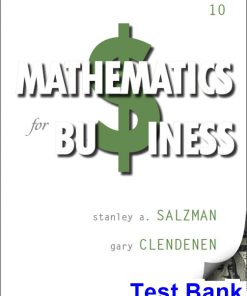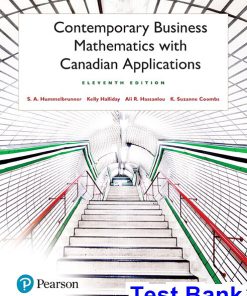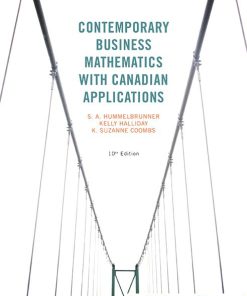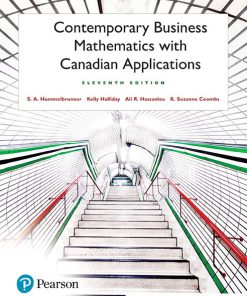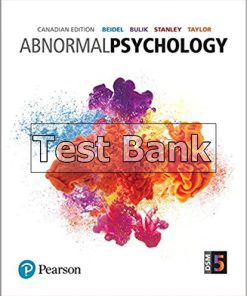Contemporary Business Mathematics Canadian 10th Edition Hummelbrunner Test Bank
$26.50$50.00 (-47%)
Contemporary Business Mathematics Canadian 10th Edition Hummelbrunner Test Bank.
You may also like
Contemporary Business Mathematics Canadian 10th Edition Hummelbrunner Test Bank
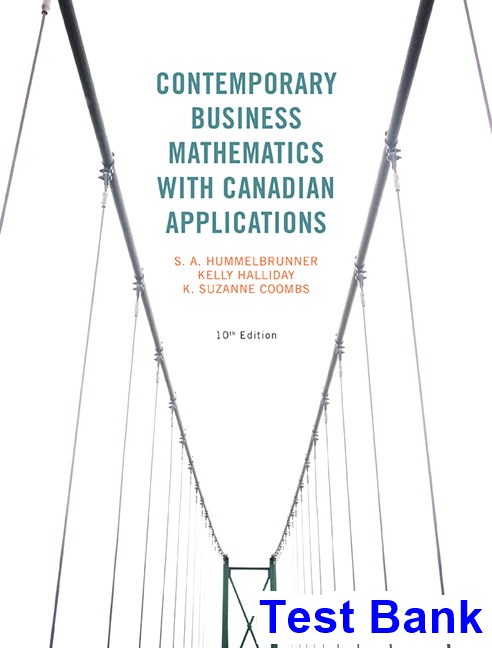
Product details:
- ISBN-10 : 0133052311
- ISBN-13 : 978-0133052312
- Author: Hummelbrunner
Conceptual and applied, with emphasis on analyzing and interpreting Canadian data to make informed business decisions. The book draws students in using a conversational writing style and delivers content with a fresh, exciting approach that reflects the authors’ blend of teaching, consulting, and entrepreneurial experiences.
Table contents:
- Part 1 Mathematics Fundamentals and Business Applications
- Introduction: Part 1
- Chapter 1 Review of Arithmetic
- Chapter 1 Review of Arithmetic
- Introduction
- 1.1 Basics of Arithmetic
- Exercise 1.1
- 1.2 Fractions
- B. Equivalent fractions
- C. Converting common fractions into decimal form
- D. Converting mixed numbers to decimal form
- E. Rounding
- F. Complex fractions
- Exercise 1.2
- 1.3 Percent
- B. Changing percents to common fractions
- C. Changing percents to decimals
- D. Changing decimals to percents
- E. Changing fractions to percents
- Exercise 1.3
- 1.4 Applications—Averages
- B. Problems involving simple arithmetic average
- C. Weighted average
- Exercise 1.4
- 1.5 Applications—Payroll
- B. Commission
- C. Wages
- Exercise 1.5
- 1.6 Applications—Taxes
- B. Property tax
- Exercise 1.6
- Review Exercise
- Self-Test
- Challenge Problems
- Case Study Businesses and the GST/HST
- Questions
- Glossary
- Chapter 2 Review of Basic Algebra
- Chapter 2 Review of Basic Algebra
- Introduction
- 2.1 Simplification of Algebraic Expressions
- B. Multiplication
- C. Division
- D. Substitution and evaluation
- Exercise 2.1
- 2.2 Integral Exponents
- B. Numerical evaluation of powers with positive integral exponents
- C. Operations with powers
- D. Zero exponent
- E. Negative exponents
- Exercise 2.2
- 2.3 Fractional Exponents
- B. Fractional exponents
- Exercise 2.3
- 2.4 Logarithms—Basic Aspects
- B. Common logarithms
- C. Natural logarithms
- D. Useful relationships
- Exercise 2.4
- 2.5 Solving Basic Equations
- B. Solving equations using addition
- C. Solving equations using subtraction
- D. Solving equations using multiplication
- E. Solving equations using division
- F. Using two or more operations to solve equations
- G. Checking equations
- Exercise 2.5
- 2.6 Solving Equations Involving Algebraic Simplification
- B. Solving linear equations containing common fractions
- C. Solving linear equations involving fractional constants and multiplication
- D. Formula rearrangement
- Exercise 2.6
- 2.7 Solving Word Problems
- Exercise 2.7
- Review Exercise
- Self-Test
- Challenge Problems
- Case Study Investing in a Tax-Free Savings Account
- Questions
- Summary of Formulas
- Glossary
- Chapter 3 Ratio, Proportion, and Percent
- Chapter 3 Ratio, Proportion, and Percent
- Introduction
- 3.1 Ratios
- B. Reducing ratios to lowest terms
- C. Equivalent ratios in higher terms
- D. Allocation according to a ratio
- Exercise 3.1
- 3.2 Proportions
- B. Problems involving proportions
- Exercise 3.2
- 3.3 The Basic Percentage Problem
- B. Computation with commonly used percents
- C. Calculating the base
- D. Calculating a percentage rate
- E. Applications
- Exercise 3.3
- 3.4 Problems Involving Increase or Decrease
- B. Calculating the rate of increase or decrease
- C. Determining the original amount
- Exercise 3.4
- 3.5 Problems Involving Percent
- B. Problems involving the computation of a percentage rate
- C. Problems involving the basic percentage relationship
- D. Problems of increase or decrease
- Exercise 3.5
- 3.6 Applications—Currency Conversions
- B. Using cross rate tables
- Exercise 3.6
- 3.7 Applications—Index Numbers
- B. The Consumer Price Index and its uses
- Exercise 3.7
- 3.8 Applications—Personal Income Taxes
- Exercise 3.8
- Review Exercise
- Self-Test
- Challenge Problems
- Case Study The Business of Taxes
- Questions
- Summary of Formulas
- Glossary
- Chapter 4 Linear Systems
- Chapter 4 Linear Systems
- Introduction
- 4.1 Graphing Linear Equations
- B. Graphing in a system of rectangular coordinates
- C. Constructing a table of values
- D. Graphing linear equations
- E. Special cases—lines parallel to the axes
- F. The slope–y-intercept form of a linear equation
- G. Special cases of the slope–y-intercept form of a linear equation
- Exercise 4.1
- 4.2 Graphing Linear Systems of Equations in Two Variables
- Exercise 4.2
- 4.3 Algebraic Solution of Systems of Linear Equations in Two Variables
- B. Solving a system of two linear equations by algebraic substitution
- C. Solving linear systems in two variables involving fractions
- D. Systems of two linear equations with no solution or many solutions
- Exercise 4.3
- 4.4 Problem Solving
- B. Problems leading to systems of equations
- Exercise 4.4
- 4.5 Graphing Inequalities
- B. Graphing inequalities of the form ax + by > c and ax + by < c
- C. Graphing inequalities of the form ax > by or ax < by
- D. Graphing inequalities involving lines parallel to the axes
- E. Graphing systems of linear inequalities
- Exercise 4.5
- 4.6 Problem Solving
- B. Problems leading to systems of linear inequalities in two variables
- Review Exercise
- Self-Test
- Challenge Problems
- Case Study Determining the Right Combination
- Questions
- Summary of Formulas
- Glossary
- Part 1 Comprehensive Case Til Debt Do Us Part
- Part 2 Mathematics of Business and Management
- Introduction: Part 2
- Chapter 5 Cost-Volume-Profit Analysis and Break-Even
- Chapter 5 Cost-Volume-Profit Analysis and Break-Even
- Introduction
- 5.1 Cost-Volume-Profit Analysis and Break-Even Charts
- B. Break-even charts
- C. Computing break-even using formulas
- D. Calculating break-even when the unit prices and unit costs are unknown
- Exercise 5.1
- 5.2 Contribution Margin and Contribution Rate
- B. Contribution rate
- Exercise 5.2
- 5.3 Effects of Changes to Cost-Volume-Profit
- Exercise 5.3
- Review Exercise
- Self-Test
- Challenge Problems
- Case Study Segway Tours
- Questions
- Summary of Formulas
- Glossary
- Chapter 6 Trade Discounts, Cash Discounts, Markup, and Markdown
- Chapter 6 Trade Discounts, Cash Discounts, Markup, and Markdown
- Introduction
- 6.1 Determining Cost with Trade Discounts
- B. The net price factor approach
- C. Discount series
- D. Single equivalent rates of discount
- Exercise 6.1
- 6.2 Payment Terms and Cash Discounts
- B. Ordinary dating
- C. End-of-the-month dating
- D. Receipt-of-goods dating
- E. Partial payments and additional problems
- Exercise 6.2
- 6.3 Markup
- B. Rate of markup
- C. Calculating the cost or the selling price
- Exercise 6.3
- 6.4 Markdown
People also search:
contemporary business mathematics for colleges
contemporary mathematics for business and consumers
contemporary business mathematics with canadian applications
contemporary mathematics for business and consumers pdf
topics in contemporary mathematics 10th edition pdf


